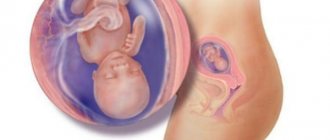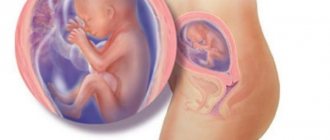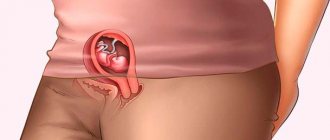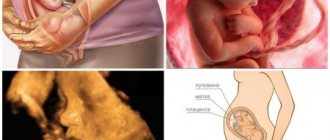The baby's movements, height and weight
Your baby is no longer as active at 40 weeks of pregnancy. You can’t really play around in mom’s belly right now—there’s not enough room. But now his thrusts are very well felt. Continue to listen to fetal movement. The norm for movements during this period of pregnancy is considered to be approximately 10 noticeable movements in 12 hours.
Any changes in the intensity and nature of the child’s movements will be a signal for the mother to consult with her doctor.
Your baby has gained about 3.5 kilograms, and his height at 40 weeks of pregnancy is approximately 52 cm. Remember that now these indicators are somewhat arbitrary and very individual.
A woman’s feelings and changes in her body
- Don't worry if you still don't have any hints about the upcoming birth. As mentioned above, most likely, you could have made a trivial mistake when calculating the gestational age.
- Continue with your normal lifestyle, but be sure to be prepared for the fact that labor may begin at any moment.
- By the way, do not forget that sex at 40 weeks of pregnancy is strictly unacceptable. As you remember, a woman’s birth canal is now actively preparing for the upcoming birth of the baby, so any possibility of infection should be excluded.
During this period of pregnancy, a woman needs to monitor all her painful sensations and analyze what exactly could have caused them. If there is even the slightest suspicion that something is wrong with you, it is better to play it safe and rush to consult a doctor.
Many expectant mothers at 40 weeks of pregnancy experience pain in the lower back, lower abdomen, and pain in the spine, back and legs. Such pain most often does not pose a threat and is caused by increased stress on the body and stretching of its muscles and ligaments. Your body is now actively preparing for the upcoming birth of a child, which contributes to the manifestation of painful sensations characteristic of this period of pregnancy.
Pain and heaviness in the groin, pubis, and pelvic bones are caused by stretching and softening of the joints and bones. Under the influence of the hormone relaxin, which softens the bones and joints of the pelvis, the pelvic bones gradually move apart, creating a certain amount of pain for the woman.
If you begin to feel shooting and stabbing pain in the thigh area, reaching to the knee, then most likely this occurs as a result of compression of the femoral nerve by the enlarged uterus.
Abdominal pain
By this time, the child is usually lowered, which pregnant women immediately notice by the absence of shortness of breath. But sometimes the stomach drops almost just before childbirth, which is also normal.
Do not be alarmed if at 40 weeks of pregnancy your stomach hurts, and nagging pain in the lower abdomen spreads to the lower back. It’s just that the baby’s head puts pressure on the mother’s pelvic bones, and the load on the woman’s lower back and stomach has also increased due to the seriously increased weight. Such symptoms indicate the imminent onset of labor, even if there are no contractions yet.
It also happens that a woman’s stomach becomes hard at 40 weeks of pregnancy. Such sensations of a hardening abdomen, which may periodically appear in expectant mothers, indicate increased uterine tone. Hypertonicity of the uterus at this stage of pregnancy indicates the imminent appearance of real contractions preceding labor.
If this is 1st pregnancy
Don't be afraid if labor hasn't started yet. Your baby can stay in your tummy for up to 42 weeks and still feel great. Try not to panic. Bearing and giving birth to a child is an individual and unpredictable process, so labor can begin at any time. Try to be prepared for this.
Pregnancy dates are not set to make you worry more, but to determine the time frame during which you will prepare for childbirth. So don’t waste time on meaningless reasoning, take better care of your baby. It is impossible to say exactly what day he will be born, so pay more attention to your health.
The nature of the discharge - what to look for
You should still continue to monitor your vaginal discharge. At 40 weeks of pregnancy, white discharge, or a light milky hue, with a noticeable mucous consistency and the absence of strong odors is considered normal.
What makes vaginal discharge sticky and sticky is the gradual separation of the mucous plug that covers the cervix until birth. It is worth noting that mucus in the discharge may not only be transparent. When the cervix softens and contracts, small vessels may burst, causing blood particles to appear in the mucus, and the woman may experience pinkish and brown vaginal discharge.
In the case when you notice the appearance of bloody discharge, even a small amount of it may indicate the development of a very bad pathology - placental abruption. Immediately go to the doctor, because placental abruption poses a serious danger to the health and life of the child and his mother.
Do not hesitate to consult a doctor if greenish, yellow, foamy, cheesy discharge appears, which contains admixtures of flakes and pus and has a strong unpleasant odor. Such changes in vaginal discharge indicate the development of an infectious disease, which, if not treated in time, can be transmitted to the child.
And in the event of immediate expiration of amniotic fluid, the mother must, taking all her bags, urgently move to the maternity hospital. A woman learns about this event by the appearance of copious watery and liquid yellowish discharge that can flow down her legs. Remember that the waters pour out in such a stream precisely on the eve of the onset of labor.
By the way, amniotic fluid can leak and leak out in small portions. This happens when the integrity of the membranes is damaged or they are depleted, which is very dangerous for your baby.
Violation of integrity allows the infection to penetrate through the protective membranes to the fetus in the next 24 hours. Therefore, if excessive moisture appears on your underwear, a woman should report it to her doctor.
Incentives: pros and cons
Today there are many different types of incentives. They were developed to help women in labor in difficult situations in which the woman’s body cannot cope on its own without medications. For example, if pregnancy has crossed the limit of 42 weeks, or there is a threat to the life of the child or mother. In such cases, doctors themselves offer stimulation. Before giving consent or refusing, a girl should know the consequences of such a decision.
In an emergency situation, for example, if a woman in labor is unconscious, stimulation can be performed without her permission. When there is neither overdevelopment nor a threat to life, it is worth thinking carefully about the issue of interfering with the natural processes of the body.
The safest stimulation is physical activity, unless of course there are contraindications from the attending physician. From 39 weeks you can induce labor by cleaning the house. Effective exercises include jumping on a ball, walking up stairs, or just walking. When walking, the baby's head puts pressure on the cervix, and it begins to open. Obstetricians advise not to forget about exercise and walks throughout pregnancy.
Artificial induction of labor
If a girl keeps herself in shape, doing the permitted exercises, and sits still less, then waiting for the child will be much easier, and there is a greater chance that the baby will appear on time. Another pleasant way of natural stimulation is sexual intercourse. It causes the release of the hormone prostaglandin, which brings the moment of birth closer, causing muscle contraction. However, you need to know when to stop so as not to harm either the child or yourself.
Read: 5 weeks of pregnancy in pictures
Artificial induction of labor occurs using special drugs. They start with those that improve blood circulation in the uterus. After this, the cervix is prepared for childbirth by prescribing prostaglandins. These drugs come in different forms: gel, tablets or injection solutions. Usually, within an hour after the start of treatment, the woman begins the labor process.
The good thing about medical incentives is that it can save lives or prevent negative consequences. Such consequences can be called fetal hypoxia, which occurs when there is a lack of oxygen, when the bubble bursts, and the contractions are too weak or begin to subside.
Stimulation will also help avoid complications if the woman in labor has chronic diseases of the heart, kidneys, thyroid gland, if blood pressure is high or if the umbilical cord has prolapsed.
Now it is worth mentioning the negative side of artificially inducing labor. It uses drugs that increase the pain effect, cause fetal suffering, and in rare cases lead to oxygen starvation or premature placental abruption. To alleviate the condition of the expectant mother, doctors have to use epidural anesthesia. Because of the IV, the woman in labor cannot take a comfortable position for childbirth. She has to lie motionless on her back, which causes significant discomfort.
If the previous birth took place using a cesarean section, then this time with artificial stimulation, there is a threat of uterine rupture along the scar.
Precursors of childbirth at the fortieth week
If you haven’t gone into labor yet, don’t worry, most likely it will happen in the coming days. Certain signs, called labor harbingers, will indicate that labor is approaching. We have created for you a kind of guide to pregnancy at 40 weeks, where you can familiarize yourself with these harbingers of labor.
- Loss of weight and appetite
Shortly before the onset of labor, a pregnant woman may experience a decrease in appetite or, almost on the eve of labor, there may be no appetite at all. At the same time, the weight of the expectant mother may also change: it decreases by a couple of kilograms, or remains the same.
- Diarrhea
Indigestion during this period of pregnancy is also a harbinger of an early birth. Diarrhea occurs a couple of days before the onset of strong contractions, which gives you the opportunity and time to calmly get ready and prepare for the trip to the maternity hospital.
- Energy boost
If you used to experience constant fatigue and drowsiness, but now you are cheerful and energetic, you have a strong desire to arrange your home, prepare a room for the baby, tidy up and clean everything in the house - get ready for the fact that very soon the moment will come when you should hurry to the maternity hospital.
- Stomach dropped
One of the main precursors of childbirth is a sinking of a woman’s abdomen. The baby descends lower in the uterus, pressing its head against its bottom, and prepares for the upcoming journey into a new life. A woman will immediately feel this, because by lowering her tummy, her breathing becomes much easier and heartburn completely disappears. In this case, the child, falling lower, can put pressure on the mother’s intestines and bladder, which causes the woman to go to the toilet frequently.
- Nagging pain in the abdomen and lower back
Aching and pulling painful sensations in the lower abdomen and lumbar region inform a pregnant woman that very soon she may experience very painful and sensitive prenatal contractions.
- Removal of the mucus plug
A clear harbinger of imminent labor is considered to be the release of the mucous plug.
If you notice that a dense lump of mucus has appeared on your underwear, 2 tablespoons in volume and with visible bloody spots, this means that at 40 weeks of pregnancy the plug has come off, freeing up the birth canal for the baby to travel.
Discharge at 40 weeks of pregnancy: the plug comes off
The mucus plug located in the cervix reliably protected the baby from all kinds of infections and negative external influences throughout the entire 40 weeks. Hormonal changes that occur in anticipation of labor prepare the cervix for further dilatation. That is why a woman often notes a change in the nature of the discharge. In order for the baby to pass through a woman’s birth canal, the uterine cervix needs to get rid of the plug. This process can last several hours, or it can take up to two weeks. If the plug comes out completely at once, the woman may see a fairly dense clot of mucus. The discharge of the mucus plug is accompanied by discharge. Their color can be any - yellow, beige, pink, brown, transparent with streaks of blood. Partial or complete release of the plug is often accompanied by discharge, incl. at the 40th week of pregnancy, similar to those during menstruation. The inclusions of blood are created by capillaries that rupture as a result of the gradual expansion of the cervix.
Important! After the mucous plug has passed, it is recommended that a pregnant woman refrain from taking a bath, going to the pool, having intimate relationships with a partner, or swimming in open water. Carefully monitor hygiene, because... Now the uterus is open to any infection.
Outpouring of waters
It is difficult not to notice the complete rupture of amniotic fluid, which occurs immediately before the onset of labor. At this moment, a watery yellowish liquid pours out of you, flowing down your legs.
If such a picture is present, the woman should immediately go to the maternity hospital, because labor can begin very soon!
- Contractions
Regular painful contractions will alert you to the imminent onset of labor. These contractions become more frequent over time, and as they progress, their pain increases.
In order not to confuse prenatal contractions with training contractions, you just need to change your body position during contractions, walk around, and then sit down again. If after this the contractions stop, it means that the pregnant woman should not rush to the maternity hospital yet.











